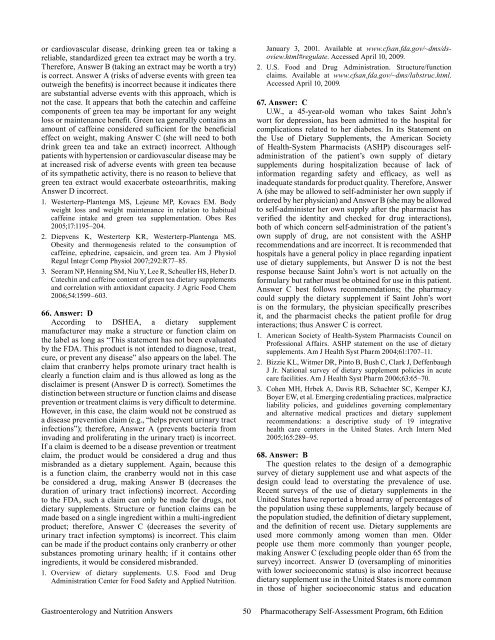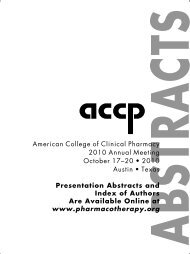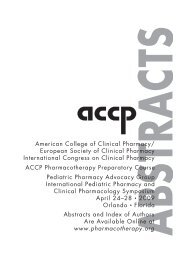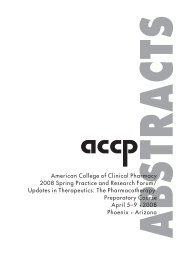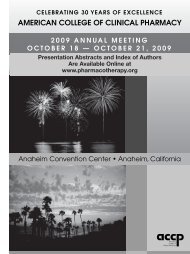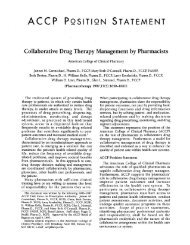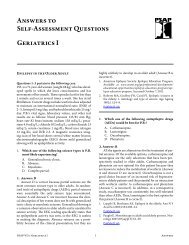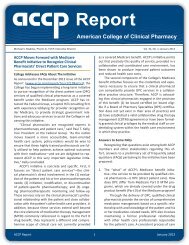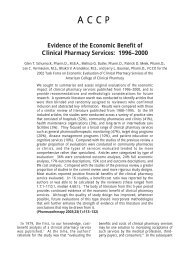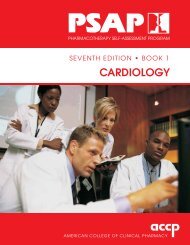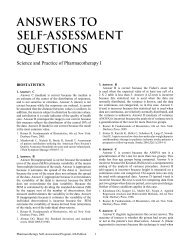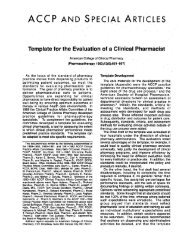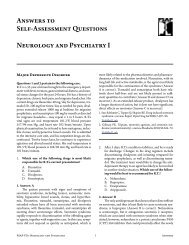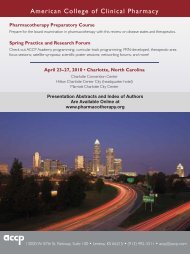Answers to Self-Assessment Questions - ACCP
Answers to Self-Assessment Questions - ACCP
Answers to Self-Assessment Questions - ACCP
You also want an ePaper? Increase the reach of your titles
YUMPU automatically turns print PDFs into web optimized ePapers that Google loves.
or cardiovascular disease, drinking green tea or taking a<br />
reliable, standardized green tea extract may be worth a try.<br />
Therefore, Answer B (taking an extract may be worth a try)<br />
is correct. Answer A (risks of adverse events with green tea<br />
outweigh the benefits) is incorrect because it indicates there<br />
are substantial adverse events with this approach, which is<br />
not the case. It appears that both the catechin and caffeine<br />
components of green tea may be important for any weight<br />
loss or maintenance benefit. Green tea generally contains an<br />
amount of caffeine considered sufficient for the beneficial<br />
effect on weight, making Answer C (she will need <strong>to</strong> both<br />
drink green tea and take an extract) incorrect. Although<br />
patients with hypertension or cardiovascular disease may be<br />
at increased risk of adverse events with green tea because<br />
of its sympathetic activity, there is no reason <strong>to</strong> believe that<br />
green tea extract would exacerbate osteoarthritis, making<br />
Answer D incorrect.<br />
1. Westerterp-Plantenga MS, Lejeune MP, Kovacs EM. Body<br />
weight loss and weight maintenance in relation <strong>to</strong> habitual<br />
caffeine intake and green tea supplementation. Obes Res<br />
2005;17:1195–204.<br />
2. Diepvens K, Westerterp KR, Westerterp-Plantenga MS.<br />
Obesity and thermogenesis related <strong>to</strong> the consumption of<br />
caffeine, ephedrine, capsaicin, and green tea. Am J Physiol<br />
Regul Integr Comp Physiol 2007;292:R77–85.<br />
3. Seeram NP, Henning SM, Niu Y, Lee R, Scheuller HS, Heber D.<br />
Catechin and caffeine content of green tea dietary supplements<br />
and correlation with antioxidant capacity. J Agric Food Chem<br />
2006;54:1599–603.<br />
66. Answer: D<br />
According <strong>to</strong> DSHEA, a dietary supplement<br />
manufacturer may make a structure or function claim on<br />
the label as long as “This statement has not been evaluated<br />
by the FDA. This product is not intended <strong>to</strong> diagnose, treat,<br />
cure, or prevent any disease” also appears on the label. The<br />
claim that cranberry helps promote urinary tract health is<br />
clearly a function claim and is thus allowed as long as the<br />
disclaimer is present (Answer D is correct). Sometimes the<br />
distinction between structure or function claims and disease<br />
prevention or treatment claims is very difficult <strong>to</strong> determine.<br />
However, in this case, the claim would not be construed as<br />
a disease prevention claim (e.g., “helps prevent urinary tract<br />
infections”); therefore, Answer A (prevents bacteria from<br />
invading and proliferating in the urinary tract) is incorrect.<br />
If a claim is deemed <strong>to</strong> be a disease prevention or treatment<br />
claim, the product would be considered a drug and thus<br />
misbranded as a dietary supplement. Again, because this<br />
is a function claim, the cranberry would not in this case<br />
be considered a drug, making Answer B (decreases the<br />
duration of urinary tract infections) incorrect. According<br />
<strong>to</strong> the FDA, such a claim can only be made for drugs, not<br />
dietary supplements. Structure or function claims can be<br />
made based on a single ingredient within a multi-ingredient<br />
product; therefore, Answer C (decreases the severity of<br />
urinary tract infection symp<strong>to</strong>ms) is incorrect. This claim<br />
can be made if the product contains only cranberry or other<br />
substances promoting urinary health; if it contains other<br />
ingredients, it would be considered misbranded.<br />
1. Overview of dietary supplements. U.S. Food and Drug<br />
Administration Center for Food Safety and Applied Nutrition.<br />
January 3, 2001. Available at www.cfsan.fda.gov/~dms/dsoview.html#regulate.<br />
Accessed April 10, 2009.<br />
2. U.S. Food and Drug Administration. Structure/function<br />
claims. Available at www.cfsan.fda.gov/~dms/labstruc.html.<br />
Accessed April 10, 2009.<br />
67. Answer: C<br />
U.W., a 45-year-old woman who takes Saint John’s<br />
wort for depression, has been admitted <strong>to</strong> the hospital for<br />
complications related <strong>to</strong> her diabetes. In its Statement on<br />
the Use of Dietary Supplements, the American Society<br />
of Health-System Pharmacists (ASHP) discourages selfadministration<br />
of the patient’s own supply of dietary<br />
supplements during hospitalization because of lack of<br />
information regarding safety and efficacy, as well as<br />
inadequate standards for product quality. Therefore, Answer<br />
A (she may be allowed <strong>to</strong> self-administer her own supply if<br />
ordered by her physician) and Answer B (she may be allowed<br />
<strong>to</strong> self-administer her own supply after the pharmacist has<br />
verified the identity and checked for drug interactions),<br />
both of which concern self-administration of the patient’s<br />
own supply of drug, are not consistent with the ASHP<br />
recommendations and are incorrect. It is recommended that<br />
hospitals have a general policy in place regarding inpatient<br />
use of dietary supplements, but Answer D is not the best<br />
response because Saint John’s wort is not actually on the<br />
formulary but rather must be obtained for use in this patient.<br />
Answer C best follows recommendations; the pharmacy<br />
could supply the dietary supplement if Saint John’s wort<br />
is on the formulary, the physician specifically prescribes<br />
it, and the pharmacist checks the patient profile for drug<br />
interactions; thus Answer C is correct.<br />
1. American Society of Health-System Pharmacists Council on<br />
Professional Affairs. ASHP statement on the use of dietary<br />
supplements. Am J Health Syst Pharm 2004;61:1707–11.<br />
2. Bizzie KL, Witmer DR, Pin<strong>to</strong> B, Bush C, Clark J, Deffenbaugh<br />
J Jr. National survey of dietary supplement policies in acute<br />
care facilities. Am J Health Syst Pharm 2006;63:65–70.<br />
3. Cohen MH, Hrbek A, Davis RB, Schachter SC, Kemper KJ,<br />
Boyer EW, et al. Emerging credentialing practices, malpractice<br />
liability policies, and guidelines governing complementary<br />
and alternative medical practices and dietary supplement<br />
recommendations: a descriptive study of 19 integrative<br />
health care centers in the United States. Arch Intern Med<br />
2005;165:289–95.<br />
68. Answer: B<br />
The question relates <strong>to</strong> the design of a demographic<br />
survey of dietary supplement use and what aspects of the<br />
design could lead <strong>to</strong> overstating the prevalence of use.<br />
Recent surveys of the use of dietary supplements in the<br />
United States have reported a broad array of percentages of<br />
the population using these supplements, largely because of<br />
the population studied, the definition of dietary supplement,<br />
and the definition of recent use. Dietary supplements are<br />
used more commonly among women than men. Older<br />
people use them more commonly than younger people,<br />
making Answer C (excluding people older than 65 from the<br />
survey) incorrect. Answer D (oversampling of minorities<br />
with lower socioeconomic status) is also incorrect because<br />
dietary supplement use in the United States is more common<br />
in those of higher socioeconomic status and education<br />
Gastroenterology and Nutrition <strong>Answers</strong><br />
50<br />
Pharmacotherapy <strong>Self</strong>-<strong>Assessment</strong> Program, 6th Edition


